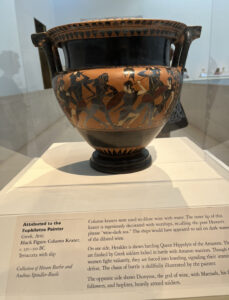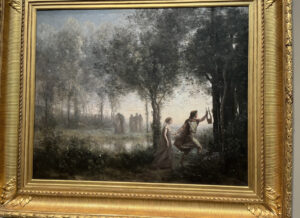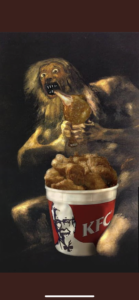
I. Creator: “The Swan’s Dream of Leda” was created by American sculptor, David Hare .
Hare’s main body of work utilized steel and bronze materials, which he would use to
create welded abstract sculptures. Hare’s artwork was heavily influenced by European
surrealists who he encountered in New York during World War 2. In combination with
surrealism, Hare was also inspired by abstract expressionists (Ashton). The surrealists
and abstractionists both shared an interest in the theories of Sigmund Freud, whose work
helped pave the way for artists to understand the unconscious mind (Landmarks). The
mix of these two movements in Hare’s artwork was a testament to his goal of “breaking
up reality” and recombining it into different “relations of memory and association”(Landmarks). The abstract nature of Hare’s art takes from the surrealist
interest in fantasy and myth and contorts this into a piece of work that ultimately seems to
“take on a life of its own” (The Art Story). Such as with “The Swan’s Dream of Leda,”
Hare loved to experiment with unconventional viewpoints and bring new perspectives to
his subjects.
II. Date of creation: Hare’s sculpture was created in 1962.
III. Location: The sculpture is situated in the Bass Concert Hall Lobby on the fourth floor.
IV. When/why the sculpture was placed on the UT campus: The sculpture is a long term loan from the Metropolitan Museum of Art in New York city. In September 2008, the
Met loaned various sculptures to Landmarks, the public art program at UT, for display
throughout campus. The collection represented various artists who worked throughout the
second half of the 20th century. The main group of sculptures was unveiled in September
2008, while a smaller group, including “The Swan’s Dream of Leda,” was unveiled at
Bass Concert Hall in January 2009 (The Metropolitan Museum of Art).
V. Type of artwork: “The Swan’s Dream of Leda” consists of two main components. The
large base is made from stone and the welded metallic structure above is formed from
bronze. The use of steel and bronze in this sculpture was typical of Hare’s artwork.
VI. Description: Looking at Hare’s sculpture may be initially confusing and perplexing. This is why it’s important to understand the context behind the myth of Zeus and Leda. Book 3 of Apollodorus’ Library explains that Leda is the queen of Sparta through her marriage with Tyndareus and is the daughter of Thestius, who is the king of Aetolia (Apollodorus 3.10.5). On the same night that Leda bedded Tyndaerus, Zeus, who desired Leda, took the form of a swan in order to seduce (rape) her. As a result of this, she gave birth to four children: Pollux and Helen, who were attributed to Zeus and Castor and Clytaemnestra, who were attributed to Tyndareus (Apollodorus 3.10.7). In other accounts of the myth the parentage varies, as all four children are sometimes attributed to Zeus, or Pollux and Castor are said to be Tyndaerus’ and Helen and Clytaemnestra are Zeus’. Another version of the myth that Apollodorus describes details that Helen is not Leda’s biological daughter at all, but rather she’s the daughter of Nemesis and Zeus (Apollodorus 3.10.7). Nemesis who was pursued by Zeus attempted to escape him by turning herself into a goose. Zeus, in turn, took the likeness of a swan and mated with her. As a result, Nemesis lays an egg, which is found by a shepherd and then brought to Leda. The myth attributes a foster-mother role to Leda, who places the egg in a chest and raises Helen as her own (Apollodorus 3.10.7).
Regardless of which version of the myth one chooses to look at, the swan plays a
significant role in each. Hare’s sculpture portrays the cutout of a woman’s figure (meant
to represent Leda) surrounded by a halo of dark feathers (Cotter). The swan myth has
been heavily depicted in many works of art and literature, but Hare’s sculpture is the only
one that shows the perspective of the swan and allows the viewer to see how the swan
might imagine Leda in his dreams (Landmarks). Someone like Hare, whose interests lie
in surrealism and Freudian principles, could have chosen to depict the obvious sexual
innuendo associated with the myth, as various artists have done before (Landmarks).
However, as with much of his artwork, Hare chose to deviate from the conventional.
Instead of depicting the “genital and phallic motifs so loved by most male surrealists,”
Hare chose to showcase more metaphorical expressions, such as the flapping of the
swan’s wings (Landmarks). Despite the raw, earthy materials, the delicate composition of
the sculpture evokes a sense of tenderness. The swan myth, while expressed delicately by
Hare, is often rooted in violence. One of the most famous examples of this is William
Butler Yeats’ poem, “Leda and the Swan.” Yeats’ poem encapsulates the relationship
between violence and power through the graphic portrayal of Leda’s assault, focusing on
the swan’s physical dominance and Leda’s helplessness (Chang and Tsung). The poem
exposes the dehumanization of Leda and emphasizes her lack of agency through the line:
“Did she put on his knowledge with his power/ Before the indifferent beak could let her
drop?” (Yeats). Yeats’ poem, rooted in sexual innuendo and brutality, is a common representation of the myth of Leda and the swan. Hare’s sculpture is special in that it takes a lyrical approach to the subject (Cotter). In looking at the sculpture, it doesn’t evoke a sense of violence. Instead it appears to be an image of a loving union meant to be viewed from the perspective of the swan.
Bibliography:
Apollodoros, “The Library Book 3”, Theoi Classical TextsLibrary, www.theoi.com/Text/Apollodorus3.html#10. Accessed 18 Apr. 2025.
Ashton, Dore. “Art: Complex Sculpture; David Hare Shows Recent Works in Exhibition
Displaying New Assurance.” The New York Times, The New York Times, 3 Dec. 1959,
timesmachine.nytimes.com/timesmachine/1959/12/03/80564254.html?pageNumber=34.
Accessed 18 Apr. 2025.
Cotter, Holland. “Review/Art; a Love Affair with Surrealism (Published 1994).” The New York Times, 14 Jan. 1994, www.nytimes.com/1994/01/14/arts/review-art-a-love-affair-with-surrealism.html. Accessed 18 Apr. 2025.
“David Hare Paintings, Bio, Ideas.” The Art Story, www.theartstory.org/artist/hare-david/.
Accessed 18 Apr. 2025.
“David Hare: The Swan’s Dream of Leda.” The Metropolitan Museum of Art, 1 Jan. 1962,
www.metmuseum.org/art/collection/search/489310. Accessed 18 Apr. 2025.
Hawk Chang, Tsung C. “Women, Power Knowledge in W.B. Yeat’s “Leda and the Swan”.”
Journal of Comparative Literature and Aesthetics, vol. 40, no. 1, 2017, pp. 59-66. ProQuest. Accessed 18 Apr. 2025.
“The Swan’s Dream of Leda.” LANDMARKS, landmarks.utexas.edu/artwork/swans-dream-leda. Accessed 18 Apr. 2025.
Yeats, William Butler. “Leda and the Swan.” Poetry Foundation, Poetry Foundation,
www.poetryfoundation.org/poems/43292/leda-and-the-swan. Accessed 18 Apr. 2025.
Written by Maria Rodriguez


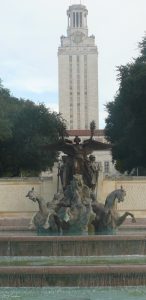
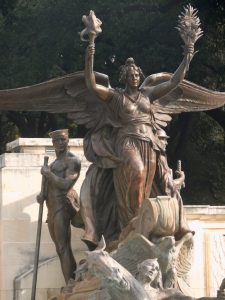
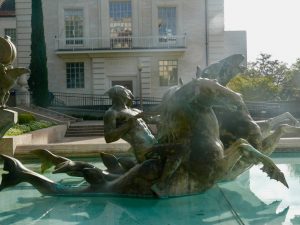

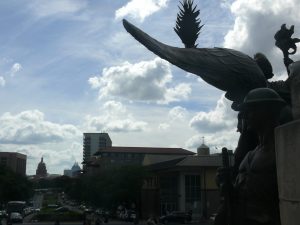


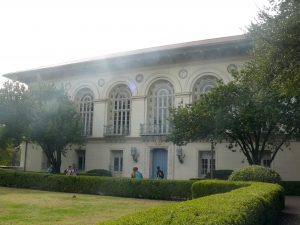
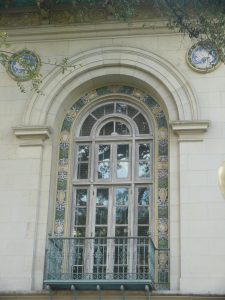
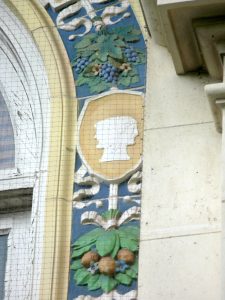
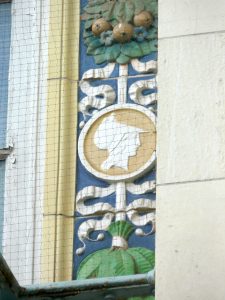



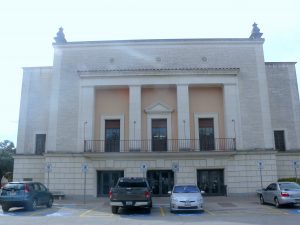
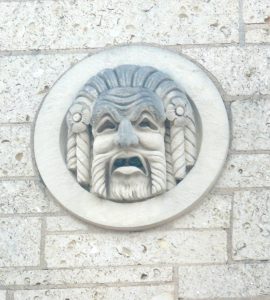 Although Greek drama, particularly tragedies, were often set in the heroic world of Greek myth, they were used as a way of investigating contemporary Greek issues. Many of the narratives of Greek myth that are preserved in the writings of mythographers are based on the dramatic tellings of Greek myths by Athenian tragedians, such as Aeschylus, Sophocles, and Euripides. In Greek myth, the dramatic arts of poetry, music, and dance were said to be inspired by female deities called
Although Greek drama, particularly tragedies, were often set in the heroic world of Greek myth, they were used as a way of investigating contemporary Greek issues. Many of the narratives of Greek myth that are preserved in the writings of mythographers are based on the dramatic tellings of Greek myths by Athenian tragedians, such as Aeschylus, Sophocles, and Euripides. In Greek myth, the dramatic arts of poetry, music, and dance were said to be inspired by female deities called  Greek comedies generally had far less to do with myth than the genres of Greek tragedy and satyr. The early Greek comedies were mainly satirical, mocking political figures and people of importance for their vanity and foolishness. Our primary example of comedy is from the playwright Aristophanes. One the few examples of Greek comedies with an extended treatment of characters in Greek myth is Aristophanes’ Frogs. Frogs tells the story of how the god Dionysus travels to the underworld to bring the tragedian Euripides back from the dead because of the poor quality of Athens’ living tragedians. The potential for irreverent depictions of the gods can be observed in the character of the god Dionysus, whose behavior and numerous errors along the way to the home of Hades provide the primary source of humor in this comedy.
Greek comedies generally had far less to do with myth than the genres of Greek tragedy and satyr. The early Greek comedies were mainly satirical, mocking political figures and people of importance for their vanity and foolishness. Our primary example of comedy is from the playwright Aristophanes. One the few examples of Greek comedies with an extended treatment of characters in Greek myth is Aristophanes’ Frogs. Frogs tells the story of how the god Dionysus travels to the underworld to bring the tragedian Euripides back from the dead because of the poor quality of Athens’ living tragedians. The potential for irreverent depictions of the gods can be observed in the character of the god Dionysus, whose behavior and numerous errors along the way to the home of Hades provide the primary source of humor in this comedy.

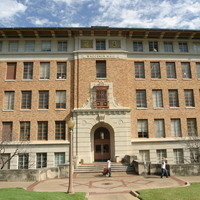

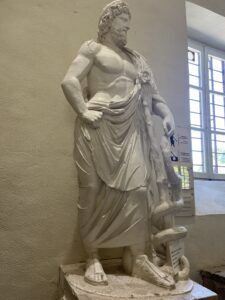
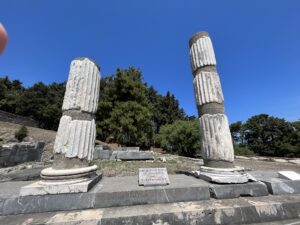
 Theogony. If you need a smile and a laugh, or a quick summary of an ancient epic poem, please have a look at the link to Epic Mythomemologies on the website.
Theogony. If you need a smile and a laugh, or a quick summary of an ancient epic poem, please have a look at the link to Epic Mythomemologies on the website.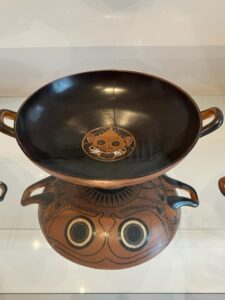
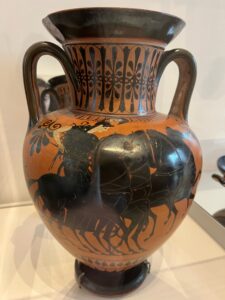
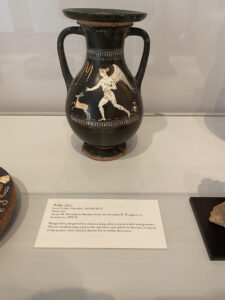
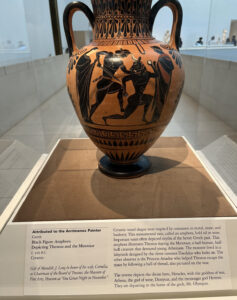 Black figure image of Theseus and the Minotaur on a Amphora dating to c. 520 BC
Black figure image of Theseus and the Minotaur on a Amphora dating to c. 520 BC